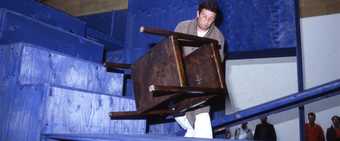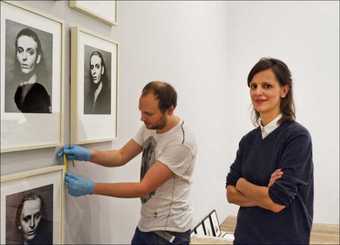
Senior Curator Catherine Wood installing the A Bigger Splash: Painting after Performance exhibition with the Tate Art Handling team
Jonah Westerman: While a great deal has been written about the relationship between painting and performance in the late 1950s and early 1960s – mostly focusing on action- or body-centred readings of abstract expressionism – it’s difficult to call to mind any study that thinks about that moment and its legacy in the way A Bigger Splash did. It seems to me that the exhibition had two parallel tracks. One traced how painting responds to what we could call the advent of performance in the late 1950s – how painting and painters have adapted to that shift in the ground of art. The other looked at how various kinds of performance have appropriated painting as a tactic or tool. What united each of these, and set A Bigger Splash on unique territory, was that performance was not set up as the dematerialisation of art but an evolution, or at least a mutation, in the life of its traditional materials.
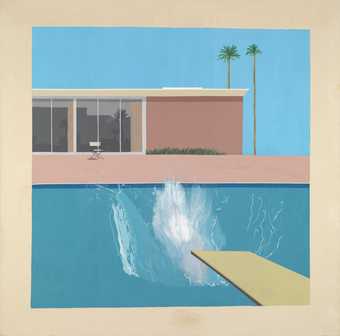
Fig.1
David Hockney
A Bigger Splash 1967
Acrylic on canvas
Tate T03254
© David Hockney 2010
That subtle reorientation happened in the show’s first gallery: Jackson Pollock’s Summertime: Number 9A 1948 was displayed in the first gallery along with David Hockney’s A Bigger Splash 1967 (fig.1). To my mind, that Pollock enunciated the now familiar story to which I just alluded –about pursuing painting to its essence, which unveils itself as a desire for immediacy; so when we look at the Pollock canvas we see the authentic, indexical traces of his true and creative self etc. The canvas is ‘an arena in which to act’; the action is what you can see even now. And in the ejaculatory tracing of that medium-specific apotheosis, art breaks. It cracks along the seams; happenings, minimalism, conceptual art and so on spill from the wound fully formed. The birth of the contemporary from the heroic self-overcoming of the modern.
But then there’s the Hockney painting A Bigger Splash. It’s a provocation, isn’t it? Almost a refutation of that narrative I just laid out, and a demand for a new one.
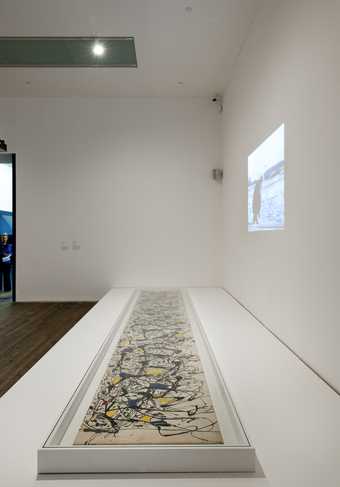
Fig.2
Installation view of Jackson Pollock’s Summertime: Number 9A with footage of Hans Namuth’s film playing above in A Bigger Splash 2012
Catherine Wood: You say I displayed the two paintings together, but one essential thing to note is that I laid the Pollock painting flat on the floor (fig.2). This literal re-orientation of it was an attempt to show it as I cannot but see it after the Namuth photos. Pollock’s paintings have, for the next generation, become traces of their making; horizontally oriented in the imagination once they have been seen on his studio floor. In the Hockney, a painting that could only be hung on the wall, the key was the laboured verisimilitude, the ‘fakeness’ of the splash. Visually, that splash rendered in these little ripples of paint that are supposed to represent the surface of a swimming pool – these bits look like marks on a Pollock painting. When you look at the painting from a distance it is almost supposed to look like he has flung a pot of paint at the canvas; Hockney said he considered literally splashing paint on to the canvas to get that effect. So he had considered an ‘action painting’ approach. But in the end it took him two weeks to paint it. Hockney is thought about as a figurative painter, a painter who copies the appearance of reality, but he had often included, even half-ingested, forms of abstraction into his compositions.
Jonah Westerman: So how does this describe a different approach to the relationship between performance and painting? Is it because it takes up the supposed moment of painting transcending itself and becoming pure presence and reabsorbs it, or appropriates it, as a style?
Catherine Wood: As a style, exactly. Hockney already knew when he was being taught how to paint in an abstract expressionist way at the Royal College of Art in the 1960s that it was a style and nothing to do with essence or transcendence, either artistic or personal. It was a style that was being exported round the world. And he could play with that.
Jonah Westerman: In the exhibition, both of these paintings were displayed alongside videos. For Pollock, the Hans Namuth documentary footage from 1951 served as witness to his process, as another indexical registration of it. But for Hockney, the moving image offered something different (fig.3).
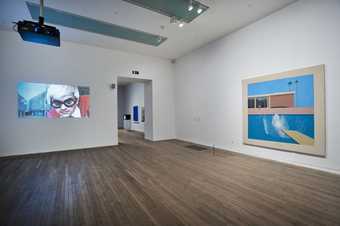
Fig.3
Installation view of David Hockney’s A Bigger Splash 1967 (right) with Jack Hazan’s film A Bigger Splash 1973 (left) in the exhibition A Bigger Splash 2012
Catherine Wood: Very different. What’s fascinating is that, according to Rosalind Krauss, the Namuth footage made Pollock feel like a phoney. It was supposed to capture the real authentic moment in the private studio, and it might be the last moment of privacy for the artist in modern art history because the film’s fame reshaped cultural expectations and, apparently, caused Pollock no small amount of self-doubt. Maybe he saw his own work being packaged as a style and this did not sit well with him. At any rate, the situation is completely different with Hockney. He willingly, knowingly, allowed Jack Hazan, a documentary filmmaker, into his life and into his studio. The resulting film appears to be a documentary but it was a new, partly scripted/partly staged approach to documentary that was then quite destabilising, even if now it has become familiar as reality TV. Hockney was in his real flat, with his real friends, making his real paintings, but the director asked him and others to re-do bits and stage bits. He would observe and then script and make them re-enact what had happened.
So it was a choreographed version of Hockney’s reality but it was performed to camera in a way that was sympathetic to the way that Hockney presented himself and his life beyond the frame as well. So I felt he used the chance to produce this performative reality as a kind of fabulation, suspended in between his life and his art, in a way that was completely different from the performed index of Pollock. Hockney represents this performative approach to reality. His way of acting, his way of dressing, these scenarios with his friends – all were drawing from the notional world of his paintings, which simultaneously reflected his lived reality. It is a very interesting back-and-forth, a kind of permission that was not about authenticity in that storied Pollock / indexical sense. It was all about style as an authentic way of living.
Jonah Westerman: So, here, from this other vantage point, performance is something that affords the coexistence of ‘fakeness’ and realness? Or rather, obviates the need to distinguish between the two?
Catherine Wood: Yes, because performativity is a way to conceive the iteration of reality through repeated acts. In Hockney’s world – between this painting and this film, and as he appeared in newspapers at the time – there’s a sense in which his speculative reality is conjured in what appear to be realist paintings. They are heavily stylised but they do nevertheless represent his real life and scenes from his life and the way he performs as an individual. There’s a slightly hammy but amazing scene in the film where he is making a painting and he gets really upset about a break up. He slashes the canvas and rips it apart. So the painting is this externalised projection of his fantasy reality that is also a backdrop to his life. And in that moment, he performs a kind of ‘action painting’ attack on the canvas but the canvas should be seen as part of his life narrative rather than the abstract support and surface of modernism.
Jonah Westerman: This is an impossible question, but what accounts for the difference between those two moments in the life of painterly authenticity, or in painting? How could the definition of performing the act of painting shift so radically between the early 1950s and the late 1960s?
Catherine Wood: I’m not sure that it did. I’m looking from a perspective rooted in the present, and it was essential to the exhibition’s concept that I was looking at both of these historical moments – then and now – through the lens of contemporary artists. Lucy McKenzie, Ei Arakawa, and other contemporary artists – many of whom work with figuration and performance – led me to understand Hockney this way. So I am not sure that the discourse itself had shifted by the late 1960s, but the practice had – and that was what I wanted to explore.
I wanted to look at the meeting point between the old story about the tables of crockery being overturned – about art breaking and becoming something new, as you said – especially as it was voiced by the artist Allan Kaprow and his call to use the ‘materials of 42nd Street’ for the new art (i.e., that all of life could be art) – the meeting point between that and this alternative idea of the performative in realism that is nothing to do with the indexical trace or given reality and everything to do with fabulation and the ancient idea of using painting to make equivalent representations of things. Instead of Kaprow’s either/or (painting/real life) I wanted to look at the expanded arena of artistic practice as a different kind of meeting point.
Jonah Westerman: I think I see the difference you are laying out – it is between the traditional narrative of art becoming immediacy and a new one about art as fully mediatised life. But it seems crucial to me that we do not forget these are historically related, and not antithetical.
That is, the old story about art and immediacy further chipped away at the winnowing boundary between art and life – ‘blurred’ it, as Kaprow would have it. As that line became so blurred, the field of things that could be considered ‘as artistic as painting’ expanded at the same time that the conceived ‘uses of painting’ multiplied as well. Maybe this is what you mean by finding the place where the stories meet?
Catherine Wood: Yes, after Kaprow, after conceptualism, after performance, there is a heightened degree of self-awareness about artistic choices that frames the decision to paint (or sculpt, or perform) in such a way that situates it within a broader set of concerns, against and within the ‘substrate’ of reality: in relation to the horizontals and verticals of the gallery architecture, in relation to the billboard in the street, in relation to the artist’s lipstick or nail varnish, and always in relation to the ghost-template of ‘painting’, as it persists in the popular imagination and our ideas of the canon. So through actionism to Wiktor Gutt, Eleanor Antin and Ana Mendieta, there is this fetishistic extension of the painted surface on to the body particularly. This idea of the living body as a surface for painting goes from the abject actionist type of work to a more formalist abstraction in the Polish experiments in the 1970s or the work of Korean artists like Lee Kang So. In feminist and queer works, it becomes quite explicitly to do with social criticism in the 1970s and 1980s.
I am interested in this expansion. How does painting go out into the world, on the body surface or on the environment? In Marc Chaimowicz’s works, painting appears as wallpaper or furniture design. On the other hand, the canvas as a framed space of representation comes back in towards the end of the show. Lucy McKenzie, for example: she performs fictional sequences, dressing up in different guises, and she uses these trompe l’oeil paintings she makes on canvas as a kind of theatre set, the representational capacity of painting comes back with a vengeance, and is wholly transporting (fig.4).
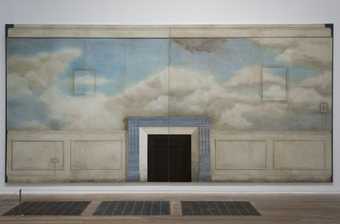
Fig.4
Installation view of Lucy McKenzie’s Slender Means 2010 in the exhibition A Bigger Splash 2012
Jonah Westerman: Yes, and those canvases look like Second Style Roman wall paintings to me – Classical with a capital C.
Catherine Wood: They are. She studied this classic form of interior décor painting deliberately in a traditional Brussels school, took that as a conceptual decision.
Jonah Westerman: Right, but – and that example demonstrates it well – this expansion of the space of representation is something that’s been part of what art does for a very long time, and not just since performance.
Catherine Wood: True. Performance might be a red herring in this show, in a funny way.It is just an excuse.
Jonah Westerman: An excuse for thinking about the different shapes of painting? I’m not sure I agree with that. Is there not still a way where we need the term performance here? Because it is historical, by which I mean it is somehow there in these works, their conditions of possibility, the way they position themselves vis-à-vis an audience, and so on. Performance is, after all, what we have come to call that Lucy McKenzie painting that makes a wall look like a window, even though it is probably not the word the Romans would have used.
Catherine Wood: Right. Well, notice the show’s subtitle: Painting after Performance. It was not about the action more than it was about the painting. It was about how performance, how these attitudes of performance and performativity as I am labelling them with the Pollock and Hockney examples have inflected the field of what is possible for painting. Lucy is more a painter than a performance artist. So is Jutta Koether. So are IRWIN.
Jonah Westerman: Yes, but the question remains: if we think about those artists and their works through performance, does it allow us to see different things about the paintings themselves? Or is the point that there is no such thing?
Catherine Wood: This ‘performance view’ opens up the painting into the world – focuses our attention on how it acts in the world – and reminds us it is not only a mimetic representation. But, really, what it insists on is that the painting does both. It frames the painting as the place where these two functions come together: what we previously called realness having to do with art as a window, as a way to frame and capture something of the world, and what we earlier called fakeness, which is not really fake at all, having to do with fashioning or creating a relation the world. The show was perversely a kind of expanded painting show, and at the same time ‘used’ painting to track the operations and movements of performative attitudes.
So I suppose with Lucy’s work, or how I think about it, the idea is that even that realism is not passive. It is actively creating a space that did not exist before even if it is a copy of a space that did exist before.
So much contemporary painting is still about awareness of the surface and everything that Clement Greenberg could have said about it. I was interested in how painting is still haunted by a prohibition on depiction, and why some painters work against that grain. The artists in this show – they all know that they are ‘not allowed’ to do that.
Jonah Westerman: So there is an element of transgression that also brings these paintings into conversation with performance?
Catherine Wood: Yes, there is a taking of permission to bring back these qualities of painting, or art more generally.
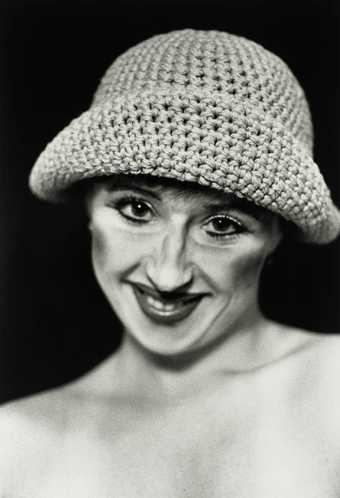
Fig.5
Cindy Sherman
Untitled A 1975
Tate P11437
© Cindy Sherman
Jonah Westerman: So are you suggesting that something that would unite works as diverse as, say, Lucy McKenzie and Cindy Sherman or Sanja Iveković, is their eliding the taboo-ness of representation and the experimental caché of ‘performance’? Essentially, that is, that the way they use painting reflects their intention to transgress?
What I mean is that, with the Sherman and Iveković works, they are appropriating culturally dominant, widely circulated stereotypes to effect some kind of persona in front of the lens. One of the things that happens when they exaggerate that stereotype is that they create a kind of minimal distance between the ideological commonplace about such and such a ‘kind of woman’ or the notion that femininity requires certain kinds of self-care and -regulation made visible through make-up – a distance between that enunciated cultural position and the artist’s own. Not that Sherman ever avowed a feminist position, but certainly Iveković has.
So what I am wondering is whether looking at all these kinds of painting through the lens of performance means we are directly confronted with issues we have inherited from modernism – namely: intentionality and the supposed authenticity of the artist’s self. Maybe performance pushes these into the spotlight?
Catherine Wood: Yes, that is definitely true. That speaks to all three sections of the show. We have discussed the prologue – the Hockney / Pollock room. Then there was a section that dealt with painting’s gradual unsticking from the canvas and moving onto the body somehow or into the lived environment, which I think of as almost applied painting. So the question of playing with identity was definitely part of that, especially in the hands of those feminist artists and queer artists. Luigi Ontani, or Derek Jarman seemed to be playing with masquerade as a form of critique explicitly, even whilst perpetuating forms of representational painting (as Eleanor Antin named her make-up video). Then, thirdly, the show went into the younger generation, beginning with IRWIN (and including Lucy McKenzie). With them, the canvas was being reintroduced as a kind of almost mystical, antiquated object that could open up the possibility of fiction, or narrative; all these things that you were not allowed to do.
Jonah Westerman: So, if I understand, you are saying there is a unifying thread through all the works in the show that entails using painting as a strategy within some kind of performance frame to mark out a space between cultural inscription and individual will. A will that articulates itself by manipulating or wielding a cultural inheritance. As if to say there is a person who has their own desires and thoughts, all of which can be in some way pulled apart from overriding cultural norms even as it depends on them. That there is a space between the mass and the individual – and one of the things that painting does in this context is mark that difference.
Catherine Wood: Yes, I quite like that. But could you not say that about any art? I think what makes it visible in this context – and maybe you have articulated what I was meaning about Hockney’s attitude to the fake splash on a realist painting – was that painting gives a frame where the questions of authorship and authenticity are most clearly visible. Like the Picasso signature on an original, framed painting – for most people, that is what makes art art – it makes art recognisable as such, invested with meaning and authority and aura. So whatever we think about painting, however much people have deconstructed and criticised it, whether we think that kind of production is relevant or not, it has this persistent power. I was interested in tracking that through the show and through recent history. It could be totally debased, like paint from a pot being poured on a naked woman along with some offal, or it is make-up, or wallpaper – and we still know that it is painting because the figure of painting is powerful in the imagination.
So this arena of the painting, this arena in which to act, is not about literal Pollock-like acting but it is – as you are suggesting – an arena for acting out your position as a subject. Back to Lucy’s copying: she is using a dead painting technique deliberately. Her authenticity is not there. She is not putting her soul on the canvas and signing it, but her authenticity is in staking out this other space. Her agency is signalled, if not laid bare.
Jonah Westerman: So here is an art historically perverse question that I have to ask you, as I think you have completely flipped the way I was thinking about all this when we started. I started by asking what happens when we put painting in a discursive frame informed by performance. But what you have done is turned that question on its head. You have turned it in a material, practical way, so that painting is the actual frame in which questions about performance get asked.
So I have to ask: insofar as it is a way of signalling the artist’s hand, a way of marking individual will, is performance just another style of painting? After the mid-twentieth century, is performance a kind of painting rather than the other way round?
Catherine Wood: I have a fantasy – probably it is not true – that the true beginning of performance art was not so much about the Burden style: I’ll get shot in the arm and that is real and provable, and you witness it, and I bleed. There is a really brutal logic to that early performance art. It sets the body against a floor, subject to the laws of physics, it is sort of Newtonian, clinical. Marina Abramović too, and Gina Pane. The creation myth of performance art is very rationalist in a weird way. I am interested in the meeting points between that struggle to achieve new forms and painting, which is the thing that performance was ostensibly breaking away from and also the reason for performance to exist. I am interested in how the meeting points resituate us in reality, how they describe a need that we have for something beyond reality. I think painting has these capacities to depict. It has this potential to be a poeticising window that stretches what reality is. The frame can do that. Maybe what interests me in painting is the maximal transformation of minimal material, especially in the context of contemporary art. I have a stubborn appreciation of painting because it has that capacity. It is this infinitely nuanced malleability of the material that I guess is what attracts artists to it as a game. Painting’s foregrounding of the ‘artist’s hand’ (in the work of the artists in this show) creates a literal link between imaginative space and bodily trace. Making painted marks could be seen as an elaborate form of ‘dressing up’ of a surface, of masquerade, which is inherently theatrical, and I am intrigued by the ways in which artists have paid minute attention to the nuances of possibility that the arena of the canvas contains, and how these possibilities might be enacted or worked into the practice of living. Weirdly, we’re back to Kaprow: but maybe – as you say – Kaprow on his head.

